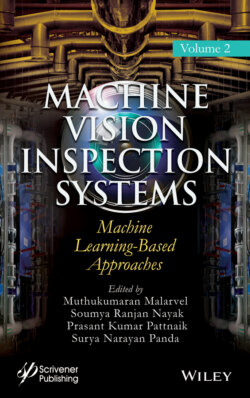Читать книгу Machine Vision Inspection Systems, Machine Learning-Based Approaches - Группа авторов - Страница 35
2.5 Discussion 2.5.1 Study Contributions
ОглавлениеThis chapter has presented a novel architecture for image verification using Siamese networks structure and capsule networks. We have improved the energy function used in Siamese network to extract complex details output by capsules and obtained on par performance as Siamese networks based on convolutional units [7], but using significantly a smaller number of parameters.
Another major objective of this study is duplicating the human ability to understand completely new visual concepts using previously learnt knowledge. Capsule based Siamese networks can learn a well-generalized function that can be effectively extended to previously unseen data. We have evaluated this capability using n-way classification using one-shot learning. The results have shown more than 80.5% classification accuracy with 20 different characters, which the model has no previous experience.
Moreover, the model is evaluated with MNIST dataset, which is considered as a de facto dataset to evaluate image classification model [30]. The proposed methodology of the capsule layers-based Siamese network has shown 51% accuracy in the classification, using only one image for each digit. Latest deep learning models achieve more than 90% accuracy [39], but that is using all the 60K images available in MNIST dataset. The solution proposed by this study has improved the one-shot learning accuracies by using n-shot learning method, that is using n samples from each image class to do the classification. This way accuracies were improved by 23.5% using 20 samples. As depicted in Figure 2.5, even 28-way learning has showed a classification accuracy of 90%, with Omniglot dataset, while MNIST dataset achieved 74.5% accuracy as shown in Table 2.4.
Further, we have extended the Omniglot dataset by adding a new set of characters for Sinhala language. This contains 600 new handwritten characters for 60 characters in the alphabet. The proposed model has given 49% accuracy for Sinhala without any training stage and it has shown a classification accuracy of 56.22% with a training model accuracy using only one reference image, as shown in Table 2.3.
By comparing with the related studies, in Koch et al. [7], the authors of Omniglot dataset, have used a convolutional layer based Siamese network to solve the one-shot problem [6]. They have shown an accuracy of 94% for class independent classification. This is a similar performance as of the proposed capsule layers-based Siamese network model. In contrast, capsule layers achieve this accuracy with 40% fewer parameters. In an experiment with MNIST dataset using one-shot learning, Koch et al. have achieved 70% accuracy [7], Vinyals et al. [27] have shown 72% accuracy, while the proposed capsule layers-based Siamese network model has given 76% accuracy. The approach in Vinylas et al. [27], is based on Memory augmented neural networks (MANN) and has a similar structure to recurrent neural networks with external memory.
